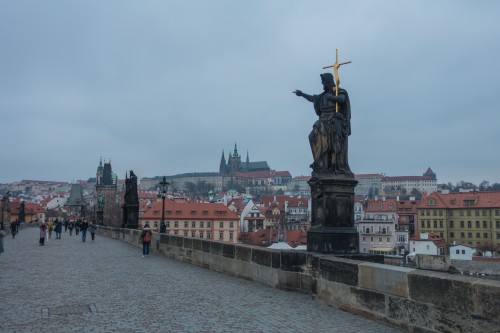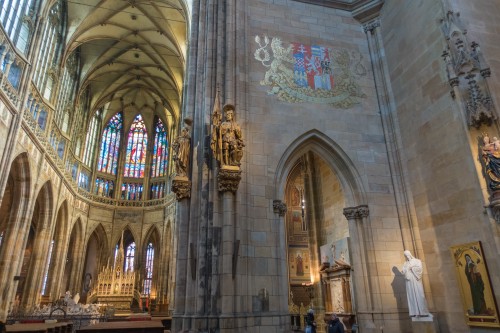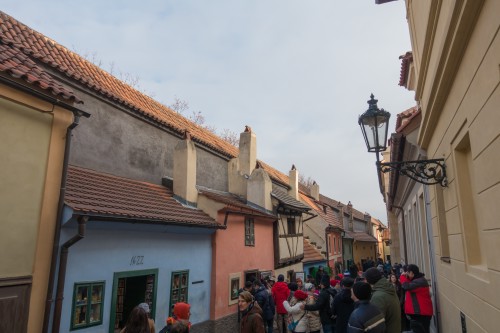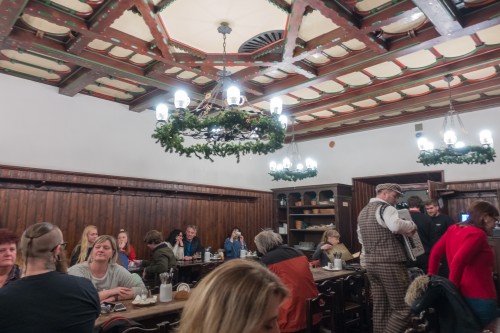

For our first morning on the trip 9 time zones away, we were pretty lucky on our sleep patterns. We went to sleep before 2, and were up at 7, long enough to feel a little rested, but hopefully tired enough we wouldn't stay up too late tonight. We knew we had a long-ish walk ahead of us, so we got ready quickly and left just before 8. The lobby at the Carlo IV was up about 20 stairs (don't know the exact number, but it was definitely even) from the street, and the walk down from the lobby seemed like it dropped about 2 degrees Fahrenheit every step. Outside, it was just getting light. We walked west again, learning from our mistakes the night before and not inadvertently heading south.
 |
 |
This time we arrived in Old Town in short order, and frankly there weren't many more people at 8:15 than there were at 1 in the morning. We saw the astronomical clock and the Christmas market stalls, but didn't dilly dally, as we had in our notes - in red font - to be at St Vitus Cathedral at Prague Castle right when it opened at 9. We had only a couple of things in red font, being at St Vitus at 9am, watching the Astronomical Clock on the hour, getting a Sisi ticket in Vienna to avoid having to stand in line for tickets at Schonbrunn Palace, and getting advanced tickets for a tour of the Hungarian Parliament building. When we crossed over the Charles Bridge, there were not very many people yet, so we took the opportunity to take some photos that literally would not be possible once the bridge was packed.
 |
 |
Once across the bridge, we headed through the Mala Strana, past a large church, wondering how we'd get up to the castle. We could see the castle, but it was well above us, and the incline up to there wasn't immediately evident on Google Maps. We'd downloaded offline maps for Prague, Salzburg, Vienna, Bratislava and Budapest, and that meant we could walk around town and search for places, plus see where we were, without using any data. That was great. But we couldn't seek specific directions, or seek the fastest route, without turning on cellular data, which we were loathe to do, especially the first day, as we didn't want to use up our data plan. So we generally walked towards the castle, and looked out for people who seemed to know where they were going.
 |
 |
Eventually we saw a ton of concrete steps, and figured that was where we wanted to be. Once at the top of the stairs, we realized we'd come up on the backside of the castle. We got there just as groups were starting to arrive. It was 8:53 when we arrived, and we were just waiting for the ticket office to open so that we could get our "Circuit B" tickets that would cover St Vitus, the Golden Lane, and a couple other spots we were interested in. We tried to go in the ticket office before 9, but the door was shut. We felt a little embarrassed, but then saw about a dozen other people try the same thing and felt a little better.
 |
 |
 |
 |
When bells started going off at 9, the office door opened and we went right in, got our Circuit B tickets, then headed straight into St Vitus. We don't think it was much warmer inside than outside. The building had a giant roof, and whatever warm air there was had long ago headed upwards. Besides the main front of the church, there were lots of side chapels, most/all of them with stained glass windows in them. The ceiling was really high throughout, with a gothic design and stained glass windows everywhere. Even as we were halfway through walking around, we could see/hear a giant mass of people starting their own visits, and we could see/feel why it was highly recommended to get here right at the opening bell (literally and figuratively).
 |
 |
Outside of St Vitus, there was a large throng of people taking selfies - we assume this will get only "worse" (depending on your point of view) as we get older year by year. Surprisingly to us, there were lots of Chinese tourists. It wasn't surprising to see Chinese tourists, as we've seen them all across the globe, but the absolute numbers and relative percentage were some of the highest we can remember. In one of the courtyards on the east side of St Vitus there was a Christmas market that had just opened, and we got a rum/honey/lemon hot drink (Justin) and hot wine (Crystal).
 |
 |
The next stop in the area was the Old Royal Palace, where we couldn't see a ton, as much of it was roped off. The ceiling had an interesting shape, with arched supports with interesting designs on the curved portions. There was also an old crown that we assume belonged to the Czech King back in the day. From there we visited St George's Basilica, which was in the same vicinity. There were some interesteing columns, half-spiral staircases, and ceiling painting, but after seeing St Vitus, it frankly didn't leave much of an impact on us.
 |
 |
The Golden Lane was next. Historically, it was the place where a number of people working at the castle and/or in the Cathedral lived, and included in the people who had lived there was Franz Kafka. Some of the houses were maintained to be historically accurate to 100 or more years ago, others had turned themselves into museums or thrift stores. The lane itself was the same size, so it was very cramped. We went into one spot that had a bunch of different types of armor and weapons from way back when. It was interesting to see how, over time, the armor became more "flexible" in terms of how many joints there were around human joints, such as the hips, waist, shoulders, elbows, etc.
 |
 |
Justin had attempted, a month or two beforehand, to group places closest together to do at the same time on the same day, so as to minimize our walking/backtracking. After the Golden Lane, the next stop was supposed to be Lobkowicz Palace, but when he searched on Google Maps, it was about a half mile away. He told Crystal we'd go somewhere else first, but just as we were about to turn Crystal said "there's a sign that says Lobkowicz Palace is right here." And sure enough, it was. We knew nothing whatsoever about the Lobkowicz Palace or why we were supposed to go there. There was an audio tour there, and so in every room we could just hit "7" or whatever and it would play an audio recording of what was noteworthy of that room. In that sense, it was nice because if it didn't look remotely interesting, you could just skip that number.
The Lobkowicz's were apparently very rich and influential for multiple centuries, and during that time amassed a ton of unique and interesting items. There were some really interesting things in the palace, including some originals of Beethoven compositions, including the photo below of the original Symphony No. 4 in B major, Opus 60. There was also an interesting story on the audio guide about another Beethoven piece on display, the Symphony No. 3 in E major, Opus 55. For Symphony No. 3, Beethoven orginally dedicted it to Napoleon, whom he thought highly of - at first. But in late 1804, Beethoven took it back, and instead dedicated it to Prince Joseph Franz Maximilian Lobkowicz, which presumably is why the Lobkowicz Palace now has it.
 |
 |
There was also a dog room, where we learned that the Lobkowicz's were at the forefront of treating dogs as part of the family, and spoiling them rotten. They had one dog that even smoked pipes, which we found amazing. Justin asked Crystal which of our dogs would have been most likely to smoke out of a pipe; Crystal, without skipping a beat said "Omar," to which Justin immediately responded "Oh, yeah, for sure" and that was the beginning and end of that discussion. The palace also had a nice terrace looking - we think - southeast towards Old Town, the Charles Bridge, and Vysehrad (another old castle complex).
 |
 |
Heading down from Lobkowicz Palace we took a different set of stairs, on the East-ish side of the Prague Castle Complex. In hindsight, we're still not sure exactly what was the "castle" as it was composed of dozens and dozens of different buildings that together were quite imposing, but it never seemed like there was a giant "wall" or one omnibus building that constituted the castle. From afar, it looks like one big complex, but up close it's obvious that rows of houses like the Golden Lane, and individual buildings such as the Lobkowicz Palace, make up the "castle" that you see from across the river.
 |
 |
 |
After being in walking areas only, it was a little odd once we saw a bunch of traffic back down at the bottom of the hill. Our next stop was St Nicholas Church, which we realized was the church we'd walked right past earlier in the day. The inside had a bunch of intricate paintings and marble(?) sculptures. After leaving the church we headed back across the Charles Bridge, and debated what to do next. It was almost 1pm, so we decided to check out the top of the hour at the Astronomical Clock. We'd read and watched some videos about it, and knew there'd be a ton of people. We scoped out a spot near a restaurant, and stood right in front of the outdoor seating area, so if we got crowded, it wouldn't be on all sides. After five or so minutes of waiting, we saw the hour change, and it was...something. We don't really know what to say other than it's something you should watch, but thankfully it's not the only thing in Prague.
 |
 |
For lunch we went to U Medivcku, just a little bit south from Old Town. We'd seen/read about it in a couple places, and it was noteworthy in that it had the original Budweiser. When Justin mentioned to Crystal he was excited to order Budweiser, she looked at him sideways until he explained that the US Budweiser brand bought its name from the original Czech beer, but they taste nothing the same. We ordered one golden Budweiser (Justin) and one dark Budweiser (Crystal). The restaurant used to be a beer house, and dates back to 1466. For food, we both narrowed our choices down to the same two things, so we decided to order one of each and share. Crystal got the wild boar dish and Justin got the half roasted duck. Both were really tasty, as was the beer.
After lunch, we headed south a little bit more and saw Wenceslas Square, which we realized we'd seen the night before on our "detour" that headed further south than we planned. Wenceslas Square has been the spot of some of the most important events in Czech history, such as Alis Jirasek reading the proclamation of independence (1918), Jan Palach and Jan Zajic setting themselves on fire to protest the Soviets (1969), and huge demonstrations that eventually led the Soviets to peacefully leave (1989).
 |
 |
From Wenceslas Square we headed east-northeast, heading generally back towards our hotel, and stopped at a place was theoretically the last remaining part of the Old City Wall. It was next to a toy store in the middle of a shopping district, and didn't look that old, so we were dubious. A couple blocks more east we saw something (which again, we'd seen the night before) that looked much more like an original City Wall part. It was very close to where we'd popped up out of the subway the night before, and also very close to our next stop, the Obecni Dum ("Municipal House") that was the temprary of home of Mucha's "Slav Epic."
Alfons Mucha is one of the most famous, if not the most famous, Czech artist. He's probably best known for the Slav Epic, which he started at age 43, which depict the history of all the Slavic peoples. There are 20 giant canvases, and it took him 14 years to paint them (between 1912 and 1926). He presented them to the Czechoslovakia on its 10th anniversary in 1928. In doing our diligence a few months earlier, we thought the Slav Epic was in a museum across the river to the north, but fortunately for us it was much closer to everything we were looking at.
The Slav Epic paintings are so big, they aren't very easy to display. They aren't all the same size, but they range from the "small" paintings that are as small as 15x12 feet to the "large" paintings that are 25x19 feet. This has apparently been a bone of contention, because the government wanted to move them in 2010 from a smaller town in the Czech Republic to Prague - so that they could be seen by more people - but nowhere in Prague has a great place to display them. The Municipal House was housing them for only a limited time.
Also, because of how fragile the paintings are, it was mandated that everyone go to the coat room before going upstairs to look at the paintings. We can only assume they didn't want a bunch of wet clothing putting too much moisture into the air in the rooms where the paintings were sitting. Best as we can recall, there were close to a dozen (maybe 11?) paintings split between two rooms, with paperwork telling us what each painting was about. Each of them had a slightly different theme, but none of them - except for the last - were particularly uplifting, and many of them depicted low moments where things could've gone permanently downhill for the Slavic people.
 |
 |
After leaving the museum, we headed back west, towards Old Town. In Old Town, we walked around the Christmas market for a bit. We realized between this and the market near St Vitus this morning that the markets were the same 6-8 stalls just repeated over and over again - sausage stand, smoked meat stand, hot wine stand, etc. There were a ton of people, and there was a children's choir that started singing - attracting a big crowd - whilst we were there. The whole Old Town looked like it was designed by someone in Hollywood or Disneyland; we felt like we were walking around a movie set the whole time.
We headed just north from Old Town into the Jewish Quarter, hoping to see some of the sites before they closed today. We tried one of the Synagogues (the Maisel), but it was already closed. We were able to get into the Old-New Synagogue, however. The ironic name is because it was originally the New Synagogue, but when an even newer one opened, it became the Old New Synagogue. The entry price seemed high to us, particularly relative to the other stuff we'd seen today. And inside there wasn't that much to see so overall it seemed like a bit of a ripoff. After leaving, we tried for one other Synagogue and for the cemetery, but everything in the Jewish Quarter was already closed. So we walked back through Old Town to one museum that didn't have much to do with any of the other items we'd seen all day - the Sex Toy Museum. It was a lot of older stuff that'd been collected (why or how we're not sure) over the decades. A lot of it looked more painful (BDSM) than pleasurable. There were no demonstrations.
 |
 |
The walk back to the hotel wasn't too long, but Justin's back was giving him trouble. His camera bag strapped around his waist was giving his lower back fits, and all the walking (and the standing) wasn't helping at all. Since he wasn't using his larger camera much, he really just wanted to drop it off. He took off the bag and carried it in his hand, but that didn't really help his back. Back at the hotel, we dropped Justin's camera bag and he laid flat on his back for a bit. Crystal did some reading and some unlaxing. Justin did some researching on where else to go, particularly since everything was closing so early. He saw that the Communism museum was open until late, and also noted that it had one of the lowest Google ratings he'd ever seen for a popular tourist site, a 3.9. We wondered why that might be, and adjusted our expectations accordingly.
We'd actually walked past the museum the night before, walking from the subway station to our hotel, but didn't even know it. Tonight, with the lights on, it was much more evident. There was also a Christmas market in the courtyard outside the museum. The museum was very nice in our opinion. There was an audio tour, and even without the audio tour there were lengthy descriptions on the wall in Czech and English (and maybe a third language, we don't recall). Long story short, the Czechs were not fans of the Soviets, especially Stalin. There was an absurdly large and expensive granite statue of Stalin that took over 5 years to build, was unveiled in 1955 (the sculptor killed himself just a few days before the unveiling), and then torn down by the Czechs in 1962. The Czechs (and the Hungarians) seemed to be the most ready to get out from under the Soviet's thumbs.
After leaving the museum, we had "dinner" at the Christmas market out front, a giant sausage. They asked if we wanted some bread to use as a bun, and we said no, but when we realized there were no plastic knives or sausages we regretted that decision. We just picked up our respective sausages and ate them by hand. Nothing else on our sites list was open at this hour (maybe 7 or 8?), so we headed to a place on our drinks list - U Flecku - for some beer. This wasn't too far from U Medvicku (where we'd had lunch) and the Hemingway Bar (where we'd had drinks the night before). Inside was a giant beer hall, with big communal tables, but we were seated at a table for two. U Flecku has only one type of beer, so they just bring around a big platter full of beers, and if you want one, they just hand it to you and mark your "bill" with another mark. After sitting down, we realized they had food too, but we were full. But we saw lots of people eating giant ham shanks and pork knuckles.
 |
 |
U Flecku has been open since 1499. We started thinking of what things were like in 1499. Best as we know (and our knowledge may be wrong), only 3+ continents had been "discovered", with nothing for South America, Australia, or Antarctica, and the knowledge of North America was just the Caribbean and maybe a bit of the east coast. [And yes, Leif Ericson had discovered a bunch of Canada by then. And the people who lived there already didn't even need to discover South America, the rest of North America, or Australia.] But, point being, 1499 was a long time ago, so it was crazy thinking that this place had been open that long. There was a guy walking around playing a keyboard, somewhat like mariachi bands at Mexican restaurants. The music was fine, but his outfit was spectacular - it looked *just* like the outfits from the "wild and crazy guys" Czech brothers skit from Saturday Night Live in the 1970s. In addition to a couple of beers, they came around a couple of times with different schnapps, one more cinnamon and one sweeter - we found the best was to drink half of each, then mix them together. We were having a great time, but knew that we had a lot to see tomorrow and that we shouldn't stay up too late again, so around 9 we left, and we were in our room and asleep around 10:30.
| Previous Day |